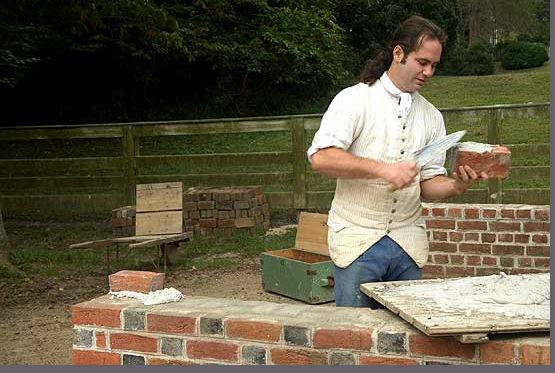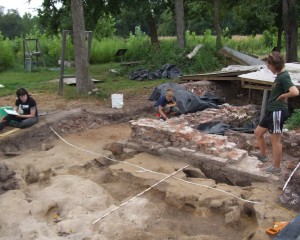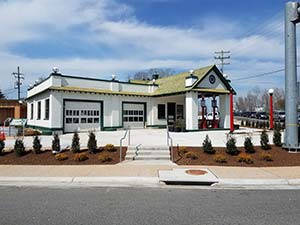Chocolate and Peanut Butter. Peanut Butter and Chocolate. These are undeniably two great things that go great together. The same should be true of archaeology and architectural conservation. Excavations frequently uncover the material remains of long lost buildings and landscape features, while these same architectural elements often inform our understanding of the past through their archaeological signature and association with artifacts of daily life. But these two disciplines more often act like oil and water. It can be a challenge to convince archaeologists to pay attention to the preservation of the built landscape. It can be equally challenging to convince architectural conservators and historians that archaeological excavations must precede ground disturbance associated with conservation.
During the last week of August, the Fairfield Foundation will host our third annual Adventures in Preservation workshop. One of our goals is to bring together experts in both of these fields and to introduce to participants the benefits that come about when these disciplines work hand-in-hand. Participants from across the United States will join us in this sold-out educational experience to learn archaeological excavation and documentation methodology while assisting staff archaeologists with their investigation of the 1694 Fairfield Manor House ruin. They will also witness, discuss, and actively participate in the historically accurate preparation of lime mortar and hand made brick that will be used to begin conserving this magnificent landmark.
 Jason Whitehead, historic brick mason at Colonial Williamsburg, applies mortar to a brick before laying it in the wall. Learn more about brick-making on the Colonial Williamsburg website!
Jason Whitehead, historic brick mason at Colonial Williamsburg, applies mortar to a brick before laying it in the wall. Learn more about brick-making on the Colonial Williamsburg website!
The key to this workshop is exposing participants to the broad range of skills necessary to properly understand, interpret, and make accessible the surviving fabric of these irreplaceable historic resources, emphasizing our responsibility as scholars and preservationists to protect and publicize our research.
Too often archaeologists are associated with the end of a site’s existence. We swoop in as the bulldozers are ready to pounce, rescuing the information from the ground. Our maps, photographs and reports testify to the site’s significance after it is sacrificed to the gods of new roads, new housing projects, and other developments. But the mentality arising from this frequent reality is one that pervades other, less destructive research projects, leaving surviving brick foundations, wood beams, and other organic and metal architectural elements to decay as our efforts focus on researching, writing, and displaying our discoveries off-site to an intrigued public. Archaeologists are often not part of a site’s conservation and long term preservation.
In a similar way, architectural historians and conservators are often associated with the elegant house museums and monuments to important people and events- life-size, accessible and easily identifiable. But when research questions or threats to a building’s stability necessitate it, the surrounding archaeological fabric is frequently ignored as an unavoidable sacrifice for the good of the building. These decisions are then frequently replicated in less dire circumstances, such as with the planting of trees, the replacement of utilities, or the “restoration” of the landscape, and the chance to learn about a property’s complex evolution through archaeology is lost.
 In many cases, such as the northeast corner of Fairfield’s foundation, extensive archaeology has taken place – and the next step is to apply preservation principles and techniques learned in this workshop to help stabilize deteriorating foundation sections.
In many cases, such as the northeast corner of Fairfield’s foundation, extensive archaeology has taken place – and the next step is to apply preservation principles and techniques learned in this workshop to help stabilize deteriorating foundation sections.
The results in both circumstances can be devastating. The unnecessary loss of original architectural fabric and the easily avoidable destruction of irreplaceable archaeological resources could be resolved by building greater respect for and understanding of the preservation principals behind each of these disciplines. There are many in each field who understand this potential and work within museum departments, often under the same roof as their counterparts, actively collaborating towards the same goals of public interpretation and long-term preservation. In Virginia, we are lucky to have many successful examples where these principles of collaborative preservation have been put to work, including Mount Vernon, Monticello, Montpelier and Poplar Forest, to name but a few. This Adventures in Preservation workshop at Fairfield has the distinct advantage of working with skilled craftsmen from another well respected institution: The Colonial Williamsburg Foundation.
Leading the workshop is one of the region’s most highly skilled and respected historic artisans, Ray Cannetti, who brings with him experience from across the eastern United States, preserving the foundations and architectural elements of historic homes, churches and public buildings from the seventeenth through the nineteenth centuries. Alongside the archaeologists of the Fairfield Foundation, the workshop participants will help stabilize and rebuild portions of the historic house ruin as we continue our efforts to learn from and share this amazing resource with others.
 Excavations adjacent the exterior of the “Mystery Room” show the facing bricks collapsing below remnants of the original cellar vent hole (just above the tip of the scale). Areas like this are where workshop participants will focus stabilization efforts.
Excavations adjacent the exterior of the “Mystery Room” show the facing bricks collapsing below remnants of the original cellar vent hole (just above the tip of the scale). Areas like this are where workshop participants will focus stabilization efforts.
It is our hope that our team can impart our skills and experiences to the workshop participants, adding them to the ranks of preservationists who will acknowledge and promote the need to protect, learn from, and make accessible our shared heritage.

